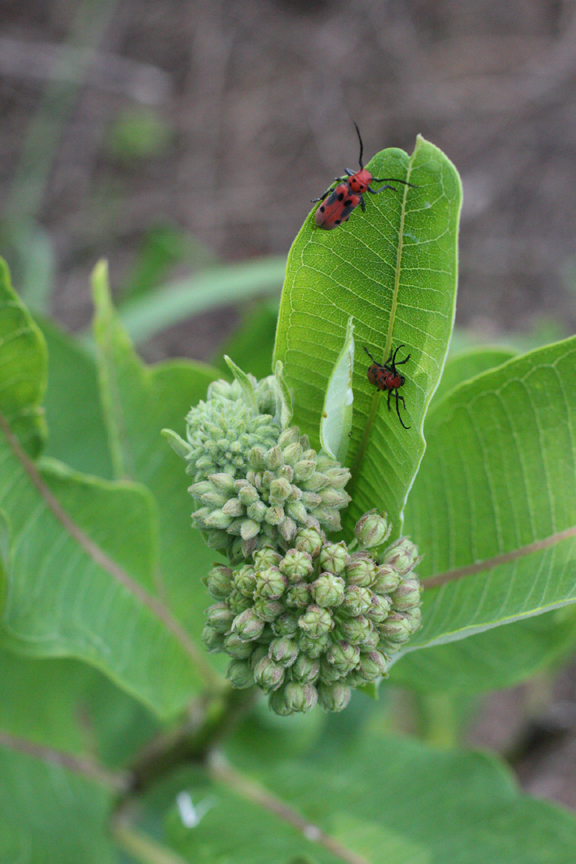I love the gardens the Lord grows—uncultivated fields containing a variety of wildflowers, grasses, and insects, not usually seen in everyday vegetable plots or flowerbeds. Years ago, when we lived on a farm in Northern Illinois, we had a big garden that was surrounded on two sides by alfalfa fields. Because of the close proximity, we ended up with a small strip on the north side that could best be described as “wild.” It was filled to overflowing with milkweed, red clover, Queen Anne’s Lace, sunflowers (from a previous sunflower house project), and Daisy Fleabane (a plant related to the Shasta Daisy with much smaller flowers).Wildflowers thrived in our garden, and the only cultivation needed was an occasional yanking—roots and all—of an invasive goldenrod that would have completely taken over if left to its own devices.
One fall, a single milkweed seed dispersed from a weather-beaten pod took hold in what was my husband’s strawberry bed. I have loved milkweed ever since I was a little girl, so I wasn’t about to evict a lone straggler. But three years later, that single plant gave birth to more than 60 offspring—all in very close quarters! It was an impressive habitat, and I was fascinated with the insect life that the milkweed supported.
One of the most interesting things I observed about milkweed is the way the large pink composite flowers bloom in succession rather than simultaneously. As the stalks grow taller, the composite flowers open— one after another— over a period of five weeks or so. This abundant food source not only offers nourishment for adult insects, but developing young as well.
I nicknamed my milkweed “The Prairie Lilac.” When friends approached our garden patch, they were surprised to smell a fragrance similar to that of lilacs. The scent is heavenly and it’s no surprise that it attracts a wide variety of insects. My husband commented that he never knew milkweed smelled so good. I believe that’s probably true for most people.
By mid-June ants could be seen trying to sip nectar from the tight-fisted blossoms before the florets even opened. Soon they were joined by bright red milkweed beetles searching for mates. Honey bees performed a tap dance of sorts, gingerly pulling their legs off the sticky flowers as they, too, drank deeply of the succulent nectar. We also saw milkweed bugs, yellow and black swallowtails, a Great Spangled Fritillary (butterfly), Hummingbird moths, earwigs (they love to sleep like crowded sardines in the folds of the leaves), ladybugs (the larvae and adults), yellow jackets, bumble bees, wasps, flies, and dragonflies.
Monarch butterflies flitted and floated among the broad green leaves of the tall milkweed stalks secretively laying their eggs. It never ceases to amaze me how the tri-colored caterpillars delight the child in all of us. Whenever we found them, we would place them in ball jars and feed them fresh milkweed leaves until they underwent the miraculous change—the anticipated moment when shimmering gold chrysalises waxed transparent, revealing the newly formed butterflies within. After their wings hardened, we released them on the summer breeze to soar high above our beloved milkweed patch—far beyond the border of our state—southward across unfamiliar territory over hundreds of miles of rough terrain to their wintering grounds in Mexico. Seeing them fly skyward caused me to contemplate the journey of life, and the beauty of a changed soul.
“For I am crucified with Christ: nevertheless I live; yet not I, but Christ liveth in me: and the life which I now live in the flesh I live by the faith of the Son of God, who loved me, and gave himself for me..”~Galatians 2:20
Yes, metamorphosis is the symbol of the Christian life—a journey across uncharted territory, over miles of rough terrain, through life’s circumstances—the chrysalis of God’s transforming power. And just as milkweed flowers bloom in succession, so too our hearts are changed, not in an instant, but over time as we look to our Creator for our spiritual sustenance and the miracle of old things made new.




BEAUTIFUL SISTER!